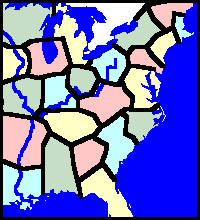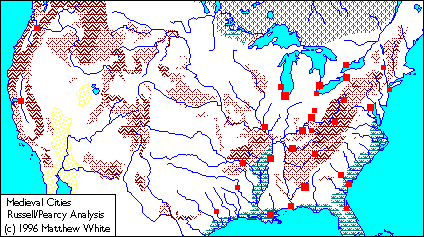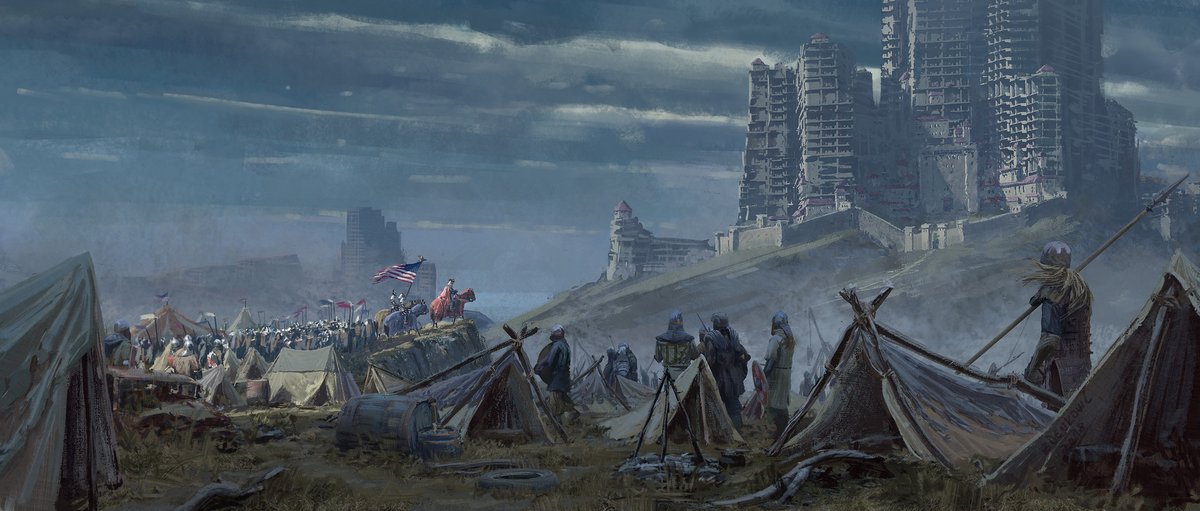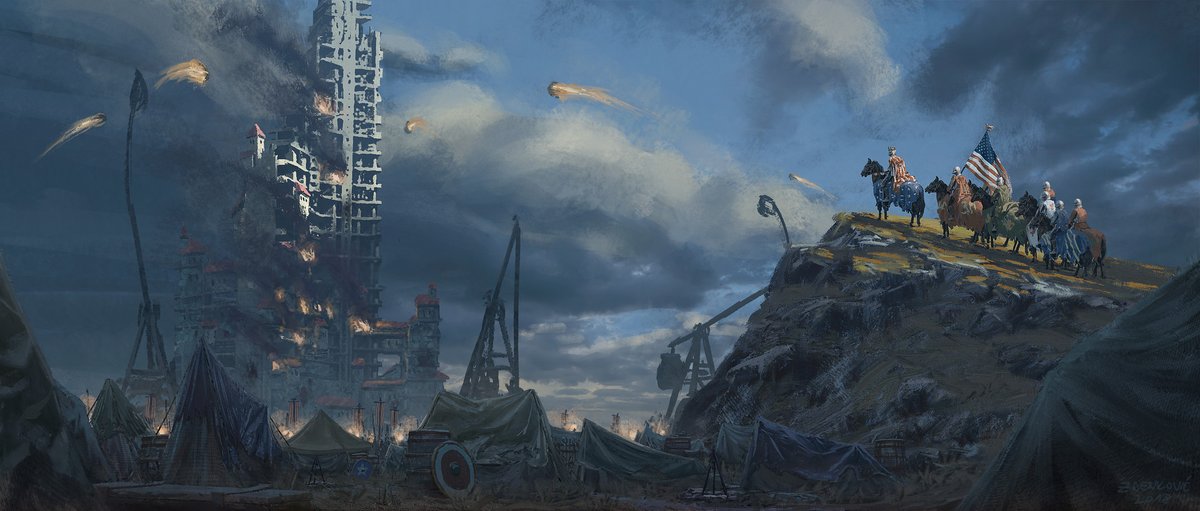The Commonwealth of Georgia
System of Government: Hereditary Feudal Monarchy
Leader: Governor Elias II Spratt
Selection of Leaders: Hereditary Primogeniture
Population: 2,700,000
Totemic Symbol: Magnolia Flower
Religion: American Non-Denominational Church
Perhaps the preeminent power of the old South, and the only eastern power capable of challenging the otherwise unquestionable superiority of the Commonwealth of Ohio, the Commonwealth of Georgia is a large, populous, prosperous nation along the south-eastern coast of Dixie. The history of the Commonwealth of Georgia is inextricably tied to the old, now unused Presidency of Georgia, and the long-standing struggle for dominance between the northern and southern halves of the American Non-Denominational Church.
The Presidency of Georgia
“One Nation, Under God, Indivisible” - that is the phrase which came to define the heart of the American Non-Denominational Church. Yet, despite the unitary sentiment, the Church has never presented a unified force to the world. Non-Denominational forces clash across the feudal heartland, District Supervisors bicker and divide in the center of the church, and Governors seek to gain advantage over one another. Typically, the concentration of District Supervisors in the north has placed the south at a distinct disadvantage in these politics, and made the Non-Denominational Church a much more northern-oriented force. Despite this, however, the position of President remained a revered one, and one which remained unused for centuries. This changed, however, with the Council of Columbia and the Coronation of President Rhett I Beauregard in 2403 by the Chief Justice of the Non-Denominational Church.
To understand the Council of Columbia, one must first understand the preceding century. With the collapse of society and the beginning of the new middle ages, the South was affected worse than most - the loss of modern conveniences such as air conditioning and pesticides made the climate unbearable for many, while man-made problems, most commonly race wars born out of pre-Event enmities, broke many Southerners off into clannish hubs. By the early 2300s, however, this had begun to see a re-integration of society into many hundreds of small polities, all proudly independent. The South, however, soon came under a new threat in the form of the Tchaktaw, the first of many nomadic peoples from the west, predating the New Israelites. Tchaktaw raids and conquests pushed in as far as Augusta and Columbia, even threatening the coastal cities of Savannah and Charleston. Tchaktaw conquests, however, proved to have less staying power, and soon they were integrated into the local population, ultimately being subsumed into the Southern culture. This did, however, create many new, powerful polities, the most substantial of which was the State of Georgia under the House of Beauregard.
Over the last three decades of the 2300s, the Beauregards expanded the power and influence, taking the important cities of Savannah, Atlanta, Columbus, and Augusta, while their seat remained at the centrally-located Macon. They expanded north, absorbing South Carolina and protecting the Chief Justice’s city of Charleston, and even held the far-off District Supervisors of Montgomery and Raleigh under their dominion. In a bid to curry favor with the newly-elected District Supervisor who had fallen victim to mob politics in Washington, Governor Rhett Beauregard placed the city under siege and secured the Chief Justice’s position. Three years later, the Council of Columbia declared that Rhett Beauregard and his line would hereafter be crowned the Presidents of Georgia, and hold in trust the lands from “the Mississippi to the James.” Such a declaration was far grander than the Beauregards’ holdings, but the unprecedented power of the Beauregards in the South had thrust it into the “Beauregardian Renaissance” and brought learning and culture back into the South.
The 2400s saw the golden age of the Beauregards come to a close as the empire steadily militarized; the many western territories, to protect against nomadic invaders, were reorganized as small marches, which would go on to give Mississippi it’s martial character. The Appalachian regions, culturally aloof and impossibly difficult to control, began to break away, as it was simply too difficult for the Presidents to go into the mountains and dislodge the inhabitants. N’awleens and Washington, those two great thessalocracies, ate away at the coasts of Georgia, with the Gullahs of the Sea Islands rising up against the Beauregards and even killing a President in 2471 - with the assistance of the United States.
The House of Beauregard would ultimately fail in 2492, and see the splintering of the Georgian heartlands. The Carolinas would each fall under the dominion of one of the brothers of the last First Lady of Georgia, while the newly-formed Commonwealth of Mississippi would expand and push the Georgian borders back from Montgomery. Georgia itself, though still large and wealthy, was divided into several competing counties, with no less than five families holding the Presidency between 2492 and 2540, when the biggest shock of all came. Ted Flannagan, a mercenary captain with acknowledged African blood, would usurp the title of President, theoretically making him second only to the Chief Justice within the realms of the American Non-Denominational Church.
Flannagan, despite his participation in a watershed moment for Southern history, was unable to establish a lasting line in Georgia. That would take until 2569, when Solon Venerable would take the throne. He would only be able to secure the stability of his realm, however, by making a deal with the Supreme Court, whereby he forewent the title of President in favor of Governor, renouncing Georgia’ unique place in the sun of the Non-Denominational Church. The Venerables, however, would be able to restore Georgia’s great power - in the 2590s, they retook Montgomery from the Mississippians, and launched several successful campaigns against the Gullahs. Most notably, Savannah would grow tremendously under their patronage, surpassing her traditional superior, Charleston, in size and wealth.
The Venerables could not last forever, however, and the disastrous drowning of Governor Wallace II Venerable in the campaigns against the Cajuns would see the rise of the powerful and respected House of Spratt, who were traditionally serving as the Marcher Lords of the Appalachians. From their base in Atlanta, where they protected the District Supervisor, the Spratts would expand their power outwards not through war, but through marriage. As a result, the last two centuries have seen Georgia’s power expand softly. Though North and South Carolina are not bound to Georgia directly, the marriages and titles held mean that they fall under the sway of Georgia more often than not. Cultivating positive relationship with both the United States and Louisiana, meanwhile, has been important in maintaining Georgia’s wealth and keeping the textiles they produce on the market. Most importantly, Georgia, with the support of Virginia, North Carolina, and South Carolina, has been the primary bulwark against Ohio’s power in the Supreme Court, a powerful advocate for the South in the religious realm.
The People of Georgia
In many ways, the Georgians are the consummate Southerners. They are deeply religious, immensely prideful, honor-obsessed, and stubbornly independent. The clannish nature of the South for centuries after the Event has never quite gone away, even as they have come to inhabit far more sophisticated political and cultural structures. As a result, local customs and local rivalries are common in Georgia, which has resulted in the development of the “Founding Fathers” culture of the region, where nearly every village and town has a legendary hero or two who helped found the village, the Commonwealth, or the whole Non-Denominational Church. These legends make up the foundation of the rich Georgian literary tradition, which goes back to the days of the Beauregardian Renaissance. While Georgia does not have the musical tradition that Mississippi does, Mississippian Troupes have become common in Georgia, where they have found a rich culture of poetry, heroic stories, and travelogues.
The nobility of Georgia reflect the same kind of Southern Gentility that those of Mississippi do. They are expected to be hospitable and respectful, deferent to social superiors, well-spoken and well-mannered, and willing to defend their honor. The Southern Vendetta, always couched in an aggrieved innocence, is practically and art form amongst the Georgians, and colors many of their interactions with outside nations. Georgian nobles are expected to be Warrior-Gentlemen, their wives, sisters, and daughters charming hostesses, and their serfs productive Christians.
While debt slavery is a fact of life in Georgia just as it is in Mississippi and other Southern nations, in Georgia the presence of urban areas has spurred on a more well-developed economic system. Debt slavery, referred to in Georgia as Indentured Servitude, takes the form of loans which are contracted through official moneylenders, and put into contracts. In this manner, peasants are not bound to the same land for generations, and can move to some extent. This means that villages can expand into towns, and that nobles must put in some amount of effort to make staying on their land attractive to the commoners.
It is important to mention one culture which does not lay entirely within Georgia’s borders - the Gullah. A people with a strange language and intimate knowledge of the seas along the Atlantic Coast, the Gullahs have long been a thorn in the side of the Georgians. They often seek independence from both Augusta and Washington, and have played the two sides off of one another for centuries. Yet they are also some of the finest sailors and navigators in the Non-Denominational world, and their presence in the cities of Savannah and the Georgian Coast have gone a long way in ensuring the rise of those regions as mercantile centers.
The Economy and Cities of Georgia
Georgia’s economy lives and dies on her production of cotton and textiles. Though cotton is not the only good produced in Georgia - timber, tobacco, and dyes also come from her fields - cotton textiles are the only value-added product that comes out of Georgia, and is the lifeblood of the cities of the Georgian coast. Most of the textiles are spun in Augusta, the largest and wealthiest city of Georgia, from which it is transported either east to Savannah, Beaufort, Sapelo, or Brunswick, where it can be traded with the many cities along the coast, or west, where it can enter the Mississippi trade routes and go either to N’awleens or Saint Louis.
Augusta, the largest city of Georgia, is also the largest and most important city in the South. From N’awleens to Baltimore, no city in the region can match Augusta in size, at over 150,000 people, nor in importance to the economy or culture of the region. The University of Augusta is the most well-regarded university in the whole of the South, founded by members of the Beauregard Dynasty over 300 years ago, and continues to produce many of the finest minds in the South. Augusta’s architecture is well-known for being the product of the late Venerable Dynasty, with telltale close columns, balconies, quatrefoil flourishes, and brightly-colored stucco exteriors. Augusta is the home to a massive amount of cotton spinners, dyers, and weavers, and their products are known throughout the Non-Denominational world.
The cities of the Georgian coast, dominated by Savannah, are equally as important. Fed by the many long, navigable rivers of Georgia, these cities are well-placed along trade routes between the Gulf, the Caribbean, and the Northeast to take advantage of the many merchants sailing these routes. For several centuries, these cities have enjoyed large degrees of autonomy from the Presidents and later Governors of Georgia, while also receiving their protection. The result of this is that the Georgian Coast is one of the wealthiest regions in the South, and contributes heavily to the Governor’s coffers. Savannah is chief among these cities, but the cities of Beaufort, Sapelo, and Brunswick have also grown to not insignificant sizes and become important parts of the local trade network.
Meanwhile, Columbus is the last major city of Georgia, where the city’s strategic location on the Chattahoochee River has allowed it to play a similar role to Savannah in funneling cotton trade south towards the Gulf. Columbus has always sat in the shadow of Augusta, Montgomery, and Mobile, and is perhaps better known for its impressive Hippodrome and the many horse races that take place there. Macon and Atlanta, while not major cities in their own right, also deserve mentions. Macon, the old capital of the Beauregard Presidents, still shows signs of their power, with a massive cathedral housing an impressive dome and collection of mosaics, as well as a powerful fortress. Atlanta, meanwhile, is the seat of Georgia’s District Supervisor, and serves as the location of many pilgrimages in Georgia itself.





